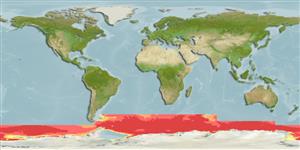Environment: milieu / climate zone / depth range / distribution range
Ecologia
marino batipelagico; oceanodromo (Ref. 51243); distribuzione batimetrica 400 - 3185 m (Ref. 1371), usually 600 - 1500 m (Ref. 1371). Deep-water; 47°S - 79°S, 180°W - 180°E (Ref. 1371)
Southern Ocean: Circumpolar (generally confined inside the Convergence except in the Falkland Islands area).
Size / Peso / Age
Maturity: Lm ? range ? - ? cm
Max length : 84.0 cm TL maschio/sesso non determinato; (Ref. 124151); peso massimo pubblicato: 5.1 kg (Ref. 124151)
Spine dorsali (totale) : 2; Raggi dorsali molli (totale) : 124 - 125; Spine anali: 0; Raggi anali molli: 110. Eyes relatively large. Snout short, moderately pointed, usually somewhat rounded with a high dorsal profile in adults, but often with prominent tubercles at its tip and lateral angles. Mouth large, lips thin. Underside of the head generally covered with small scales. Pyloric caeca 18 to 28. Overall color dark brown to swarthy in most individuals, but some are much paler; fins and lips blackish (Ref. 1371).
Remains of natant crustaceans (especially euphausiids), polychaetes, and fish (gonostomatids) have been found in the stomachs of three specimens examined.
Life cycle and mating behavior
Maturities | Riproduzione | Spawnings | Egg(s) | Fecundities | Larve
Cohen, D.M., T. Inada, T. Iwamoto and N. Scialabba, 1990. FAO species catalogue. Vol. 10. Gadiform fishes of the world (Order Gadiformes). An annotated and illustrated catalogue of cods, hakes, grenadiers and other gadiform fishes known to date. FAO Fish. Synop. 125(10). Rome: FAO. 442 p. (Ref. 1371)
IUCN Red List Status (Ref. 130435)
Threat to humans
Harmless
Human uses
Pesca: commerciale
Strumenti
Special reports
Download XML
Fonti Internet
Estimates based on models
Preferred temperature (Ref.
123201): -0.1 - 1.4, mean 0.6 °C (based on 598 cells).
Phylogenetic diversity index (Ref.
82804): PD
50 = 0.5312 [Uniqueness, from 0.5 = low to 2.0 = high].
Bayesian length-weight: a=0.00200 (0.00120 - 0.00331), b=3.21 (3.06 - 3.36), in cm total length, based on LWR estimates for this species & (Sub)family-body (Ref.
93245).
Trophic level (Ref.
69278): 3.5 ±0.49 se; based on food items.
Generation time: 20.0 ( na - na) years. Estimated as median ln(3)/K based on 2
growth studies.
Resilienza (Ref.
120179): Molto basso, tempo minimo di raddoppiamento della popolazione più di 14 anni (Preliminary K or Fecundity.).
Fishing Vulnerability (Ref.
59153): High to very high vulnerability (68 of 100).
Climate Vulnerability (Ref.
125649): High vulnerability (65 of 100).
Nutrients (Ref.
124155): Calcium = 21.3 [6.7, 49.7] mg/100g; Iron = 0.311 [0.139, 0.894] mg/100g; Protein = 17.2 [14.9, 19.6] %; Omega3 = 0.113 [0.044, 0.283] g/100g; Selenium = 25.4 [8.2, 68.7] μg/100g; VitaminA = 27.1 [3.5, 217.6] μg/100g; Zinc = 0.472 [0.256, 0.945] mg/100g (wet weight);
